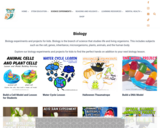
Biology Experiments and Activities for Kids
- Subject:
- Biology
- Life Science
- Material Type:
- Activity/Lab
- Date Added:
- 02/01/2023

Biology Experiments and Activities for Kids
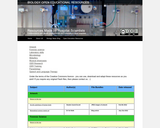
Assorted biology-related OER including biomedical science, biology and forensic science. OER in multiple formats including video, animations and downloadable text.

This activity is used in an introductory biology course to help teach experimental design and characteristics of life. Students use real research videos and art to help explore the concepts.
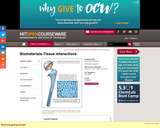
"This course covers the principles of materials science and cell biology underlying the design of medical implants, artificial organs, and matrices for tissue engineering. Methods for biomaterials surface characterization and analysis of protein adsorption on biomaterials. Molecular and cellular interactions with biomaterials are analyzed in terms of unit cell processes, such as matrix synthesis, degradation, and contraction. Mechanisms underlying wound healing and tissue remodeling following implantation in various organs. Tissue and organ regeneration. Design of implants and prostheses based on control of biomaterials-tissue interactions. Comparative analysis of intact, biodegradable, and bioreplaceable implants by reference to case studies. Criteria for restoration of physiological function for tissues and organs."
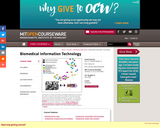
" This course teaches the design of contemporary information systems for biological and medical data. Examples are chosen from biology and medicine to illustrate complete life cycle information systems, beginning with data acquisition, following to data storage and finally to retrieval and analysis. Design of appropriate databases, client-server strategies, data interchange protocols, and computational modeling architectures. Students are expected to have some familiarity with scientific application software and a basic understanding of at least one contemporary programming language (e.g. C, C++, Java, Lisp, Perl, Python). A major term project is required of all students. This subject is open to motivated seniors having a strong interest in biomedical engineering and information system design with the ability to carry out a significant independent project. This course was offered as part of the Singapore-MIT Alliance (SMA) program as course number SMA 5304."

This course presents the fundamentals of digital signal processing with particular emphasis on problems in biomedical research and clinical medicine. It covers principles and algorithms for processing both deterministic and random signals. Topics include data acquisition, imaging, filtering, coding, feature extraction, and modeling. The focus of the course is a series of labs that provide practical experience in processing physiological data, with examples from cardiology, speech processing, and medical imaging. The labs are done on the MIT Server in MATLABĺ¨ during weekly lab sessions that take place in an electronic classroom. Lectures cover signal processing topics relevant to the lab exercises, as well as background on the biological signals processed in the labs.
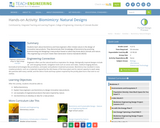
This is a multi-day activity in which student will learn what biomimicry is, explore current examples of biomimicry that exists in the fields of technology, engineering, humanities, social interactions and many other. After the initial learning is completed student pair up and create a new invention that uses biomimicry.

This subject deals primarily with kinetic and equilibrium mathematical models of biomolecular interactions, as well as the application of these quantitative analyses to biological problems across a wide range of levels of organization, from individual molecular interactions to populations of cells.
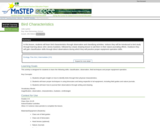
This activity is an introduction to the study of birds. Students will gain observation and classification skills.
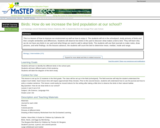
This activity is a field investigation of the bird population in the schoolyard and how the students will plan to attract more birds.
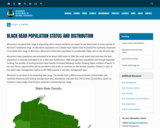
Wisconsin's occupied bear range is expanding, which means residents can expect to see black bears in areas outside of the bear's traditional range. An abundant population and suitable bear habitat have facilitated the southerly movement of occupied bear range in Wisconsin. Wisconsin's black bear population is considerably higher than it was 30 years ago.
Wisconsin's bear population was estimated to be about 9,000 bears in 1989. The most recent data indicates the bear population is currently estimated to be a little over 24,000 bears. DNR manages bear population size through regulated hunting. The number of hunting permits have steadily increased following studies showing higher numbers of bears. In the near future, opportunities will be provided to the public to comment on the desired numbers of bears in each of the state's bear management regions as the DNR prepares a new bear management plan.
Wisconsin is not alone in its expanding bear range. The results from a 2008 survey of eastern United States and Canadian Provinces that actively manage black bear populations indicated that 75% of these jurisdictions report an increase in bear range. Only Vermont reported a contracting bear range.
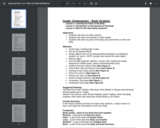
Students will name six body systems.
Students will name one function of each system.
Students will name six parts of the body and locate them on their own
body.
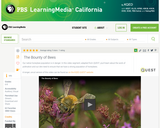
Bees are an extremely vital part of life on this planet. In this video segment from QUEST, explore the huge impact these small insects have on our civilization.
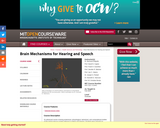
An advanced course covering anatomical, physiological, behavioral, and computational studies of the central nervous system relevant to speech and hearing. Students learn primarily by discussions of scientific papers on topics of current interest. Recent topics include cell types and neural circuits in the auditory brainstem, organization and processing in the auditory cortex, auditory reflexes and descending systems, functional imaging of the human auditory system, quantitative methods for relating neural responses to behavior, speech motor control, cortical representation of language, and auditory learning in songbirds.
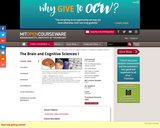
Survey of principles underlying the structure and function of the nervous system, integrating molecular, cellular, and systems approaches. Topics: development of the nervous system and its connections, cell biology or neurons, neurotransmitters and synaptic transmission, sensory systems of the brain, the neuroendocrine system, the motor system, higher cortical functions, behavioral and cellular analyses of learning and memory. First half of an intensive two-term survey of brain and behavioral studies for first-year graduate students. Open to graduate students in other departments, with permission of instructor.

Activity to help students differentiate how disciplines focus on a problem.

This classroom lab is a guided practice for inquiry using brine shrimp as the subject to be investigated.
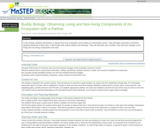
This activity is a field investigation where students gather data on physical characteristics of the ecosystem surrounding their school.
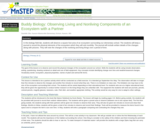
This activity is a field investigation where students gather data on physical changes of the ecosystem surrounding their school habitat.

This unit will teach students about “Carbon and Ecosystems.” They will begin by analyzing the four spheres: biosphere, hydrosphere, atmosphere, geosphere and how they are interconnected. They will understand that one system cannot exist without the other in order to maintain proper functioning within our planet. The students will learn about the various types of ecosystems that exist and how living organisms depend on other living and non-living organisms for survival. This being said, students will examine how the spheres interact and how changes in one, affects another. Students will understand that ecosystems are fueled by the energy from the sun and cycles from which they are powered.
It will focus on what the carbon cycle is and its’ influence in our lives. Carbon is essential for all life on Earth and is also in our atmosphere. It regulates the Earth’s temperature and provides an essential source of the energy to fuel our economy. The carbon cycle describes how carbon moves throughout the Earth’s spheres. By gaining a deeper understanding of how carbon moves, we can better regulate our daily decisions to help sustain our future.